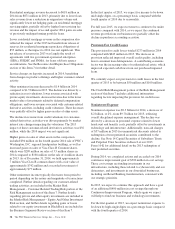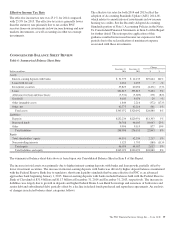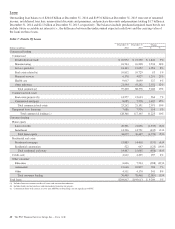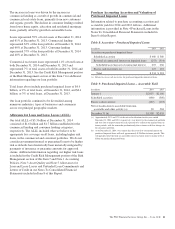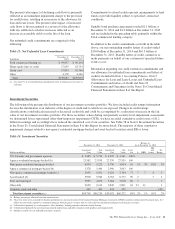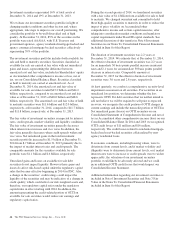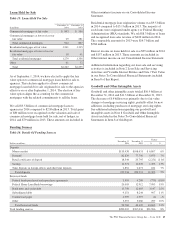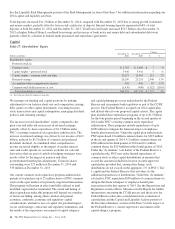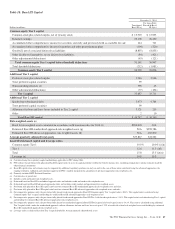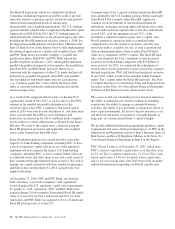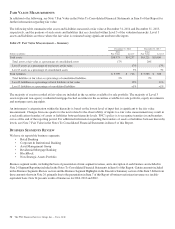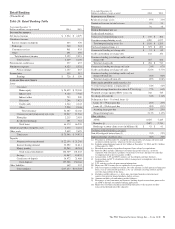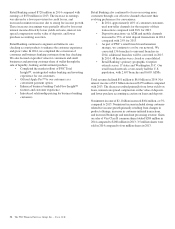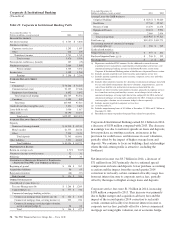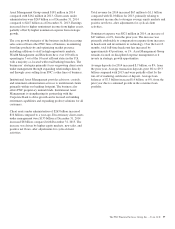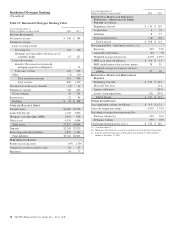PNC Bank 2014 Annual Report Download - page 66
Download and view the complete annual report
Please find page 66 of the 2014 PNC Bank annual report below. You can navigate through the pages in the report by either clicking on the pages listed below, or by using the keyword search tool below to find specific information within the annual report.The Basel II framework, which was adopted by the Basel
Committee on Banking Supervision in 2004, seeks to provide
more risk-sensitive regulatory capital calculations and promote
enhanced risk management practices among large,
internationally active banking organizations. The U.S. banking
agencies initially adopted rules to implement the Basel II capital
framework in 2004. In July 2013, the U.S. banking agencies
adopted final rules (referred to as the advanced approaches) that
modified the Basel II framework effective January 1, 2014. See
the Supervision and Regulation section in Item 1 Business and
Item 1A Risk Factors in this Report. Prior to fully implementing
the advanced approaches to calculate risk-weighted assets, PNC
and PNC Bank must successfully complete a “parallel run”
qualification phase. Both PNC and PNC Bank entered this
parallel run phase on January 1, 2013. Although the minimum
parallel run qualification period is four quarters, the parallel run
period for PNC and PNC Bank, now in its third year, is
consistent with the experience of other U.S. banks that have all
had multi-year parallel run periods. After PNC exits parallel
run, its regulatory risk-based capital ratio for each measure
(e.g., Common equity Tier 1 ratio) will be the lower of the
ratios as calculated under the standardized approach and the
advanced approaches.
As a result of the staggered effective dates of the final U.S.
capital rules issued in July 2013, as well as the fact that PNC
remains in the parallel run qualification phase for the
advanced approaches, PNC’s regulatory risk-based capital
ratios in 2014 were based on the definitions of, and deductions
from, capital under Basel III (as such definitions and
deductions are phased-in for 2014) and Basel I risk-weighted
assets (subject to certain adjustments as defined by the Basel
III rules). We refer to the capital ratios calculated using the
Basel III phased-in provisions and applicable risk-weighted
assets as the Transitional Basel III ratios.
Federal banking regulators have stated that they expect the
largest U.S. bank holding companies, including PNC, to have
a level of regulatory capital well in excess of the regulatory
minimum and have required the largest U.S. bank holding
companies, including PNC, to have a capital buffer sufficient
to withstand losses and allow them to meet the credit needs of
their customers through estimated stress scenarios. We seek to
manage our capital consistent with these regulatory principles,
and believe that our December 31, 2014 capital levels were
aligned with them.
At December 31, 2014, PNC and PNC Bank, our domestic
bank subsidiary, were both considered “well capitalized,”
based on applicable U.S. regulatory capital ratio requirements.
To qualify as “well capitalized,” PNC and PNC Bank were
required during 2014 to maintain Transitional Basel III capital
ratios of at least 6% for Tier 1 risk-based and 10% for Total
risk-based, and PNC Bank was required to have a Transitional
Basel III leverage ratio of at least 5%.
Common equity Tier 1 capital as defined under the Basel III
rules adopted by the U.S. banking agencies differs materially
from Basel I. For example, under Basel III, significant
common stock investments in unconsolidated financial
institutions, mortgage servicing rights and deferred tax assets
must be deducted from capital to the extent they individually
exceed 10%, or in the aggregate exceed 15%, of the
institution’s adjusted Common equity Tier 1 capital. Also,
Basel I regulatory capital excludes accumulated other
comprehensive income related to securities currently and
previously held as available for sale, as well as pension and
other postretirement plans, whereas under Basel III these
items are a component of PNC’s capital. The Basel III final
rules also eliminate the Tier 1 treatment of trust preferred
securities for bank holding companies with $15 billion or
more in assets. In 2013, we completed the redemption of
several series of trust preferred securities previously assumed
through acquisitions. PNC still holds trust preferred securities
in one Trust, which would not be included within Common
equity Tier 1 capital under the Basel III final rules. See Note
12 Capital Securities of a Subsidiary Trust and Perpetual Trust
Securities in the Notes To Consolidated Financial Statements
in Item 8 of this Report for more detail on this Trust.
The access to and cost of funding for new business initiatives,
the ability to undertake new business initiatives including
acquisitions, the ability to engage in expanded business
activities, the ability to pay dividends or repurchase shares or
other capital instruments, the level of deposit insurance costs,
and the level and nature of regulatory oversight depend, in
large part, on a financial institution’s capital strength.
We provide additional information regarding regulatory capital
requirements and some of their potential impacts on PNC in the
Supervision and Regulation section of Item 1 Business, Item 1A
Risk Factors and Note 20 Regulatory Matters in the Notes To
Consolidated Financial Statements in Item 8 of this Report.
PNC’s Basel I ratios as of December 31, 2013, which were
PNC’s effective regulatory capital ratios as of that date, were
10.5% for Tier 1 common capital ratio, 12.4% for Tier 1 risk-
based capital ratio, 15.8% for Total risk-based capital ratio
and 11.1% for leverage ratio. Our 2013 Form 10-K included
additional information regarding our Basel I capital ratios.
48 The PNC Financial Services Group, Inc. – Form 10-K


